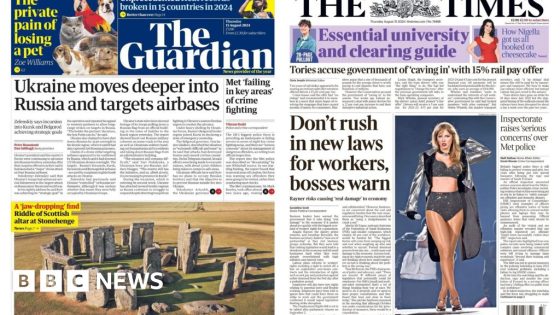In the heart of an internally displaced people’s camp in Khan Younis, Mai Ayoub gets into position: hands curled into a fist, one foot in front of the other, toes pointed forward.
In the open, sandy space between tents, the 17-year-old lines up with about six other girls on a large, red and beige straw mat, dusty from use — their only piece of equipment for this evening’s boxing class.
“We train because we’re in a state of fear,” she told CBC freelance videographer Mohamed El Saife. “We’re stressed.”
The Israel-Hamas war is into its 11th month, and almost 80 per cent of Palestinians in Gaza have been displaced to the centre of the strip in designated safe zones.
It’s in this area where Ousama Ayoub, a boxing coach, runs his makeshift boxing class this August evening. He goes to different schools and camps to teach his classes, trying to help young girls deal with their feelings of living through a war. (Ousama is not related to Mai.)
“The girls will call us and tell us to come to their camps because they like boxing,” Ousama told El Saife. “We have energy we want to get out.”
A makeshift boxing gym
Coach Ousama watches over his class, who practise jabs and uppercuts as he counts them down. They go from one combination to the next as the sun begins to set on Khan Younis and the reality of what the war has done to Gaza.
Before the war, Ousama had his own gym in Gaza City, training over 50 girls, mostly university students, to bob, weave and throw punches. He said he wanted to encourage young girls to take up the sport, which typically skews male, hoping it would help them face their fears.
But after Oct. 7, he lost his home, his gym and all his equipment, after the Israel Defence Forces entered Gaza, where much of the fighting was initially focused in the north.
For many of his students, the class is one of the few opportunities they have to put their worries of the war aside and practise.
“I’ve been boxing for four years,” said Mai. “But of course my gym was destroyed.”
“We box so we can get all the negative energy out of us.”
Shrinking safe zones amid ceasefire talks
Israel launched its war in Gaza after a Hamas-led attack on southern Israel on Oct. 7 killed 1,200 and took about 250 hostage, according to Israeli figures. The responding incursion into Gaza has killed more than 40,000, according to Palestinian tallies.
And, after months of negotiation, a ceasefire appears still out of reach. Mediators met in Doha last week and urged Israel and Hamas to come to an agreement to see the end of the war, which has ravaged much of the Gaza Strip.
In a statement by the United States, Egypt and Qatar posted last week on X, they said the meeting’s aim was to “conclude” negotiations and set the path for “bringing relief to the people in Gaza and easing regional tensions.”
After a weekend of deadly airstrikes in the Gaza Strip, U.S. Secretary of State Antony Blinken arrived in Israel for another attempt to broker a ceasefire with Hamas.
On Sunday, in a post on Telegram, Hamas said it had “dealt responsibly” with efforts by mediators during the negotiations to reach an agreement.
The group said it had already agreed to a May proposal presented by U.S. President Joe Biden. It claimed that Israeli Prime Minister Benjamin Netanyahu “is still putting obstacles in the way of reaching an agreement,” and is “prolonging the war.”
U.S. Secretary of State Antony Blinken said Monday that Israel had agreed to a U.S.-backed ceasefire proposal, and urged Hamas to do the same, though he did not state whether it had addressed the group’s concerns.
Hamas criticized Blinken’s statement, telling Reuters, “We don’t need new Gaza ceasefire negotiations, we need to agree on an implementation mechanism.”
Blinken said this week’s round of negotiations, taking place in Cairo, is “probably the best, maybe the last, opportunity” to achieve a ceasefire and return the hostages.
As the talks continue, people living in Gaza remain bearing the brunt of the war’s impact. A United Nations report from July states that nearly 83 per cent of the territory had been placed under evacuation orders, or designated a “no-go zone,” by the Israeli military.
Boxing relieves stress of war
It starts to get dark in Khan Younis as the girls wrap up the last round of moves they practised with Ousama.
With all their might, they throw hooks and one-two punches that land straight in his palm. Every hit relieves some of their stresses from what they’ve lived through the last months.
Ousama moves down the line of students, giving each a different combination to try out. Through frowns and clenched fists and teeth, they throw as hard and as fast as they can.
“One, two,” he yells out. “Left, right!”
He counts to six as they throw their punches against his palms.
“Faster!”
“I hope the war will end soon,” said Mai. “So we can go abroad and compete against other countries.”
After about an hour, she goes on her way, friends in tow, down the sandy path home — back to the tent to which she was displaced.
Source Agencies




